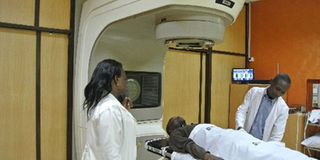New KU centre eyes cancer treatment

Doctors prepare a patient for treatment using a Linear Accelerator (Linac) machine at Texas Cancer Centre. PHOTO | FILE | NATION MEDIA GROUP
What you need to know:
The university sees a much a bigger and specific role for KUH, besides being a referral hospital.
The university intends to bring the best experts to brainstorm and explore a paradigm shift for the nation in dealing with cancer.
Less than 30 per cent of patients with detected cancer survive in Africa, compared to more than 95 per cent in Europe.
Among the ‘Big Four’ pillars of Kenya’s transformation agenda launched by President Uhuru Kenyatta, and according to a draft budget policy, the government envisages achieving a 100 per cent health coverage for every Kenyan.
Kenyatta University seeks to play a key role in this transformation plan through Kenyatta University Hospital (KUH). The institution sees its role as being a cog in the wheel of ‘Uhurucare’.
The university sees a much a bigger and specific role for KUH, besides being a referral hospital. It wants to be part of the panacea in the larger conversation about tackling cancer, the scourge that has robbed us of our brothers, sisters, parents and even children.
KU wants to play its role in two ways. First, later this year it will host the National Conference on Cancer Management for the first time, at the University Amphitheatre. The theme of the conference will be ‘The Fight Against Cancer: Where Are We?’
DEALING WITH CANCER
The university intends to bring the best experts to brainstorm and explore a paradigm shift for the nation in dealing with cancer.
Secondly, and in keeping with its mandate and strategic plan, the university and General Electric (GE) have partnered to build a Molecular Imaging Centre (MIC) that will offer comprehensive cancer care to Kenyans.
What makes the KUH MIC unique? There are two other MICs in Africa — in South Africa and Egypt. Besides, it will address the gap of “lack of efficient cancer screening and diagnosis” in the East African region.
The project will ensure that Kenya is compliant with comprehensive cancer care, as defined by World Health Organisation (WHO). It will also cover all the requisite areas of cancer care — prevention, screening, early and accurate diagnosis, treatment, survivorship and supportive care.
TREATMENT CENTRE
KUH will position the country to join the legion of first equipment responders in the region and become the premier regional cancer treatment centre.
The project is expected to be delivered on a managed equipment services (MES) model — which has been successfully used by the Ministry of Health to deliver quality healthcare throughout the country. The MES will run over seven years.
The MIC will be complete with a bunker and a cyclotron (a particle accelerator machine) capable of producing radioisotopes that can support 20 to 30 cancer centres in Kenya.
The modern equipment — from X-ray to CT, MRI and PET — have the capacity to detect cancer early or provide the avenue for treatment. For example, PET (short for “positron emission tomography”) scan doesn’t give you just images; it also shows how your body is working, provides information about blood flow and how the body uses oxygen and sugar.
MODERN EQUIPMENT
The MIC is expected to meet the needs of the university by establishing a comprehensive cancer centre with full capabilities to advance the research, diagnosis and treatment using the most modern equipment and technology.
The KUH MIC project is necessary for Kenya and the region for several reasons. First, research has shown that cancer is treatable if detected at an early stage.
However, the region’s ability to provide accurate and early cancer diagnosis and follow-up is impeded by the lack of PET scanning. Diagnosis is done too late and survivorship is only 30 per cent, compared to 70 per cent in countries that have the capacity to conduct molecular scanning.
Less than 30 per cent of patients with detected cancer survive in Africa, compared to more than 95 per cent in Europe.
ENABLE TREATMENT
Secondly, Kenya, and indeed East Africa, does not have a cancer centre that meets the definition of WHO with requisite modern equipment such as PET scans that can diagnose cancer early enough to enable treatment.
Thirdly, Kenyans spend up to Sh8 billion annually seeking cancer treatment abroad. This money could easily be harvested and re-used locally to enhance cancer research, diagnosis and treatment. The MIC will help to save foreign exchange while attracting in-bound medical tourism and, therefore, generating income for Kenya and creating visibility.
CANCER CARE
By establishing the centre, Kenya, through KU, will provide leadership in the field of cancer research across the region. As a leading teaching institution, KU will target to mould various professionals in the field of cancer care.
The facility is 98 per cent complete. When it finally opens, the KUH MIC is bound to go a long way in supporting cancer treatment and care, thus improving survivorship of patients and reducing their suffering.
Prof Wainaina is Vice-Chancellor, Kenyatta University. [email protected]





